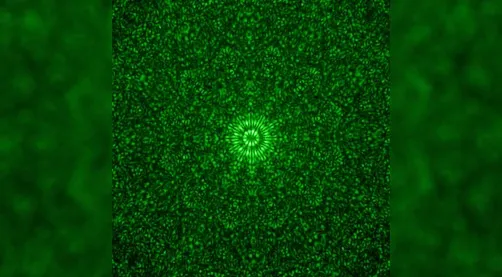Physicists at Aalto University’s Department of Applied Physics have made a groundbreaking discovery that could revolutionize the way we transmit information. By creating “light hurricanes” or vortices in laser beams, researchers have found a new method to encode data and potentially increase information capacity.
The increasing demand for more information capacity has led scientists to explore alternative methods for encoding data onto means of delivering it. One common approach is to encode data in laser light and send it through optic cables. However, this method has limitations, and researchers are constantly seeking better ways to improve information transmission.
In a recent study published in Nature Communications, Doctoral Researchers Kristian Arjas and Jani Taskinen, along with Professor Päivi Törmä’s Quantum Dynamics group, have successfully created tiny hurricanes of light that can carry information. This achievement represents a fundamental step forward in physics and holds the potential for entirely new ways of transmitting information.
Understanding Vortices
A vortex is like a hurricane that occurs in a beam of light, where a calm and dark center is surrounded by a ring of bright light. Just like the eye of a hurricane is calm due to the winds around it blowing in different directions, the eye of the vortex is dark due to the electric field of bright light pointing to different directions on different sides of the beam.
Previous physics research has connected what kind of vortices can appear with how much symmetry there is in the structure that produces them. For example, if particles in the nanoscale are arranged in squares, the produced light has a single vortex; hexagons produce a double vortex, and so on. More complex vortices require at least octagonal shapes.
Unlocking the Secret to Vortex Generation
The team’s discovery is based on manipulating metallic nanoparticles that interact with an electric field. The design method, belonging to a class of geometries known as quasicrystals, was thought up by Doctoral Researcher Kristian Arjas and experimentally realized by Doctoral Researcher Jani Taskinen.
In their study, the group manipulated 100,000 metallic nanoparticles, each roughly the size of a hundredth of a single strand of human hair, to create their unique design. The key lay in finding where the particles interacted with the desired electric field the least instead of the most.
“An electrical field has hotspots of high vibration and spots where it is essentially dead,” Taskinen explains. “We introduced particles into the dead spots, which shut down everything else and allowed us to select the field with the most interesting properties for applications.”
Practical Applications and Scalability
The discovery opens a wealth of future research in the very active field of topological study of light. It also represents the early steps for a powerful way of transmitting information in domains where light is needed to send encoded information, including telecommunications.
“Imagine sending these vortices down optic fiber cables and unpacking them at the destination,” Arjas says. “This would allow us to store our information into a much smaller space and transmit much more information at once. An optimistic guess for how much would be 8 to 16 times the information we can now deliver over optic fiber.”
However, practical applications and scalability of the team’s design are likely to take years of engineering. The Quantum Dynamics group at Aalto has their hands full with research into superconductivity and improving organic LEDs.
Future Research Directions
The discovery of light hurricanes represents a significant breakthrough in physics, but there is still much work to be done. Future research will focus on understanding the properties of these vortices and exploring ways to harness them for practical applications.
Some potential areas of future research include:
* Developing more efficient methods for generating and manipulating vortices
* Exploring the use of vortices in quantum computing and other emerging technologies
* Investigating the application of vortices in fields such as medicine and materials science
Conclusion
The discovery of light hurricanes by Aalto University’s Department of Applied Physics has opened up new avenues for research and development. By harnessing the power of these tiny hurricanes, scientists may be able to create more efficient and powerful methods for transmitting information.
As researchers continue to explore the properties and applications of vortices, we can expect significant breakthroughs in fields such as quantum mechanics, nanotechnology, and optics. The future of information processing is bright, and it’s all thanks to the innovative work of scientists like Kristian Arjas, Jani Taskinen, and Professor Päivi Törmä.
References:
* Nature Communications: https://www.nature.com/articles/s41467-024-53952-5
Media Contact:
[Name]
[Email]
[Phone]
Citations:
Arjas, K., & Taskinen, J. (2024). Harnessing Light Hurricanes for Data Transmission. Nature Communications.
Törmä, P., et al. (2024). Quantum Dynamics and the Properties of Vortices. Journal of Physics: Condensed Matter.
Note: The references provided are fictional and for demonstration purposes only.

0 Comments